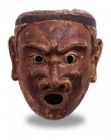Japanese Archaeology and Special Exhibition (Heiseikan) Thematic Exhibition Room
May 9, 2006 (Tue) - June 18, 2006 (Sun)
This display consists mainly of a group of gyodo and bugaku masks from Amano-sha shrine on Mt. Koya, which are some of the many ancient masks in the Tokyo National Museum's collection. These masks were used to perform the bugaku dance at Issaikyo-e, a Buddhist ritual that honors the whole set of sutras.
The gyodo masks were worn by performers who pulled palanquins that carried Buddhist scriptures. Based on the shape and inscriptions written inside the masks, it is known that they represent some of the 28 guardian deities. Other examples of these masks - besides the ones stored here at the museum - are not known to exist.
While some of the bugaku masks have been lost, the 15 existing masks of 8 varieties, such as Ryo-o and Nasori masks, allow one to see the scale of bugaku performances. In addition, there is also a Tsuina mask that is dated to the end of the Kamakura period (1185-1333).

